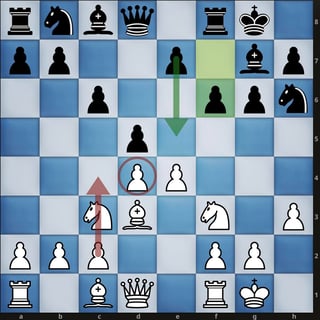After 1. e4 c6 2. d4 d5, what are the differences between 3. Nc3 and 3. Nd2?
It seems 3. Nc3 is more popular, though after 3. ... dxe4, I failed to see the difference.
After 1. e4 c6 2. d4 d5, what are the differences between 3. Nc3 and 3. Nd2?
It seems 3. Nc3 is more popular, though after 3. ... dxe4, I failed to see the difference.
3.Nd2 is more exact as it maintains flexibility over the c-pawn!How that might be relevant becomes clearer when considering specific cases, for instance, as pointed out by fuxia, 3.Nd2 avoids the possibility of 3...g6.
More precisely, in view of the concrete 3...g6 option:
3.Nc3Nc3 blocks the c-pawn and allows black to comfortably aim for the solid kingside fianchetto setup with 3...g6, providing the g7 bishop decent scope on the long a1-h8 diagonal along which multiple
white targets stand. Although the immediate e5 response in an attempt to close the diagonal is possible, black is well able to keep playing on the dark squares and undermine white's d4,e5 setup with early f6, c5 and white has to
invest extra tempo to reinforce with c3. Moreover, white often ends up with a temporarily (until f4 can be played) weak isolated pawn on e5
which black should target.
With the fiachetto'ed bishop on g7, black wants to keep the play on the dark squares and further enable their bishop. In view of this, the delayed advance of the c2-pawn means white is slower in shifting the central tension over to light squares, which in turn means black gets comfortable equalising chances, as their fight for the center goes unchallenged.
For a demonstration of the 3.Nc3 g6 line, first game that springs to mind is Smyslov vs Seirawan, where black benefited from a better fight for the center, exploiting the pressure on the long diagonal and white's delayed c-pawn advance to trade the c7 for the d4 pawn and establish a pawn majority in the center (see the diagrams below, progression from left to right). And black proceeded to draw the game comfortably while having the better endgame (dominating white's pawns on the queenside after c4-b5 conceding an outpost to the d7 knight).



Caption:
d4 is not firmly defended and cannot be reinforced with c2-c3, thus remains prone to exchanges with the c7-c5 pawn followed by the e5 advance.Ne2, c4 has been too slow (green), thus, black finds a timely resolution of white's central pawns (red), after which black achieves a clear pawn majority (right diagram) in the center (blue).3.Nd23.Nd2 instead of Nc3, maintains flexibility over the c-pawn, in particular, it prevents 3...g6 as white can readily strike in the center (with c4) and immediately challenge black on the light squares (diagram below), specially in reply to black setups typified by the pervious diagrams.
f6 black opts for Bg4 pinning the f3 knight and undermining d4's defense, then white has the important fortifying option of c2-c3 readily available. Therefore, after 3.Nd2, the g7 bishop stands poorly on the long diagonal which renders the whole 3...g6 option much less attractive for black.
In contrast to the game against V. Smyslov, Karpov never extended the same kindness towards Seirawan and always played the more exact 3.Nd2 (example games: (1), (2), (3)).
3.Nc3 allows White to play the Two Knights Attack with 2.Nf3. It does block the c-pawn, though, so Black can play 3...g6, the Gurgenidze System, because White cannot protect the d-pawn with the c-pawn.
There is also the rarely played Gurgenidze Counter Attack 3...b5. A very dubious line that can be stopped easily with a3.
3.Nd2 tries to avoid these lines, but it makes the Two Knights Attack impossible, a line that is very popular nowadays. It also blocks the view of White's dark-squared bishop, so Black can develop their kingside knight to h6 if they want.
d4 is a move in almost every line of the Two Knights, although it is often played a bit later. There is one line with d3, but it's rather rare and probably a bit too passive.
Nd2 avoids this line:
1.e4 c6 2.d4 d5 3.Nc3 b5!? 4.ed5 b4 followed by recapturing on d5
IM Jeremey Silman was a proponent of this for Black as a surprise weapon.
Yes, if Black plays 3...dxe4 there is no difference whatsoever.
The difference between 3.Nc3 and 3.Nd2 is the sidelines they allow/prevent Black from playing. For example, 3.Nc3 may encourage 3...b5!?, trying to harass the knight.
It doesn't really matter – the only difference is against g6, which is considered not very good by theory and is rare. Nd2 is slightly better against g6, and technically Nd2 might be slightly more precise, but at the end of the day 99% of the time it doesn't matter (and even Nc3 g6 isn't bad at all).
It is subtle and positional. It avoids lines white does not want to see and does it without any drawbacks that are significant.